|
|
Post by Lee Martin on Sept 30, 2015 19:02:40 GMT -5
The only thing left for this thread is the Bench build. If you choose to end it now or after the build keep me informed of the results on your shooting. Just for fun I am going to say that the Coal that touches the lands will give best results. Oh one more technical question. How much more pressure is increased when jambed into the lands? I do realize that it depends upon how far the bullet is jambed but according to my non expertise, I am roughly figuring about 1000 PSI Do you have an idea of let's say .005 to .0010 into the lands, what or how much pressure would be increased? Trust me, I will laugh so hard, and loud that you will hear me in Virginia, if you give me your Dad's answer. Charles The thread is far from done Charles. There’s still a lot to cover – shooting, wind management, reloading, cleaning, BR history, and best of all actual competition. You also asked about long seating. Precision Shooting ran an article on the subject in the 1990s. The figures escape me, but ’10-in’ hardly moved the needle. If the loaded round matches the chamber and bore, a reasonable jam is safe. -Lee www.singleactions.com"Chasing perfection five shots at a time" |
|
|
|
Post by Lee Martin on Sept 30, 2015 19:04:37 GMT -5
New Range, New Bench – Step 18 _____________________________________ We built the loading bench and bought T-111 for the gables. Weather permitting we’ll install them this Sunday. The bench sits on 4 x 4” posts. These are cross-drilled for angle iron tabs: 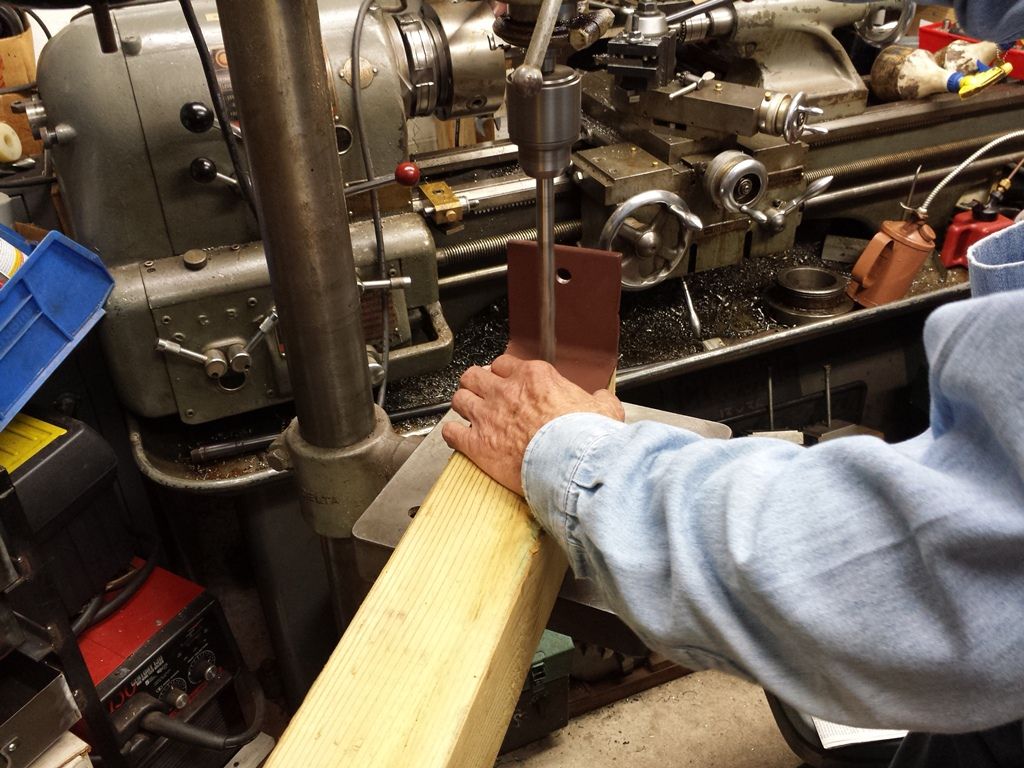 2 x 8” lumber forms the outer frame: 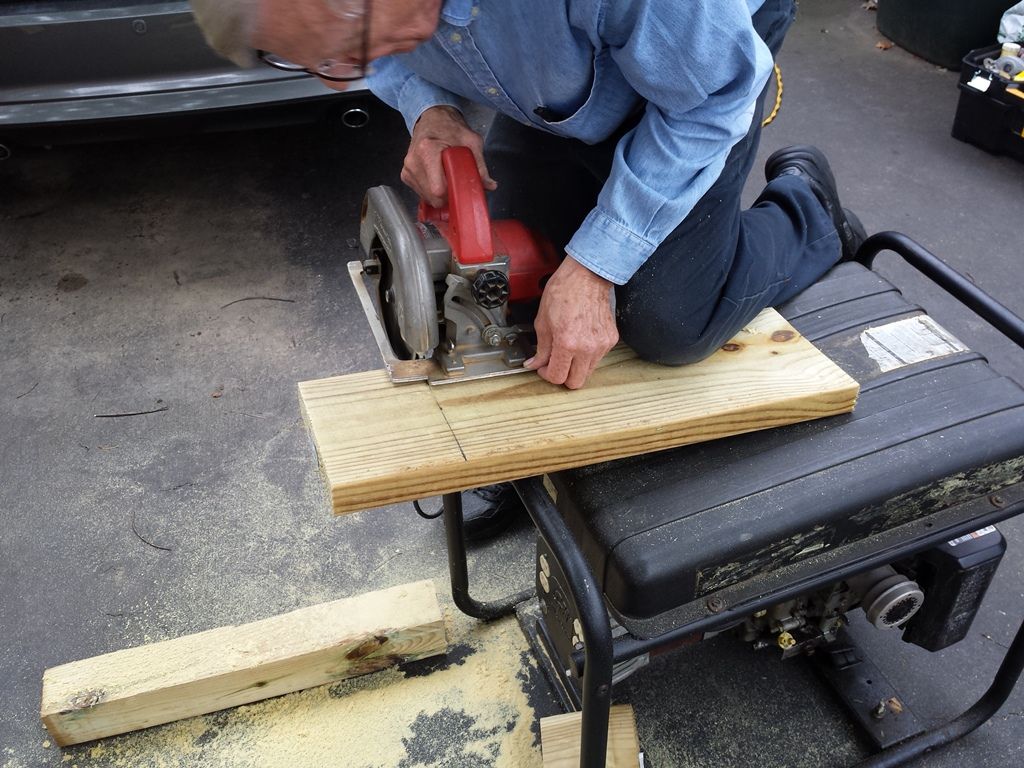 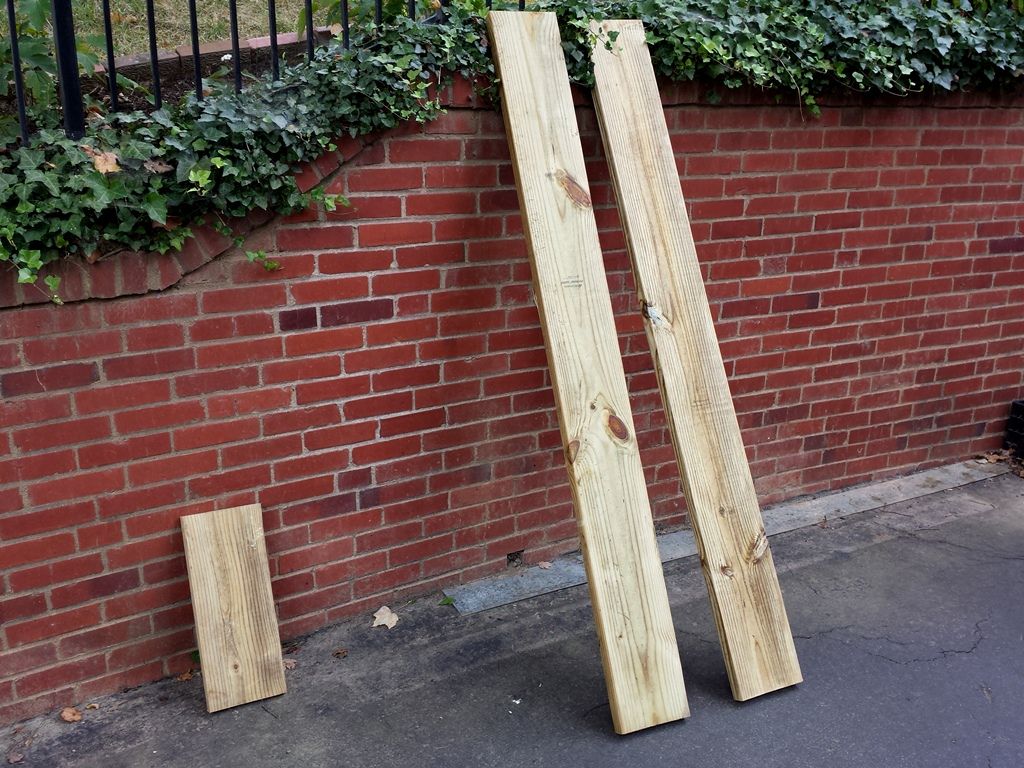 Squaring the sides to the legs: 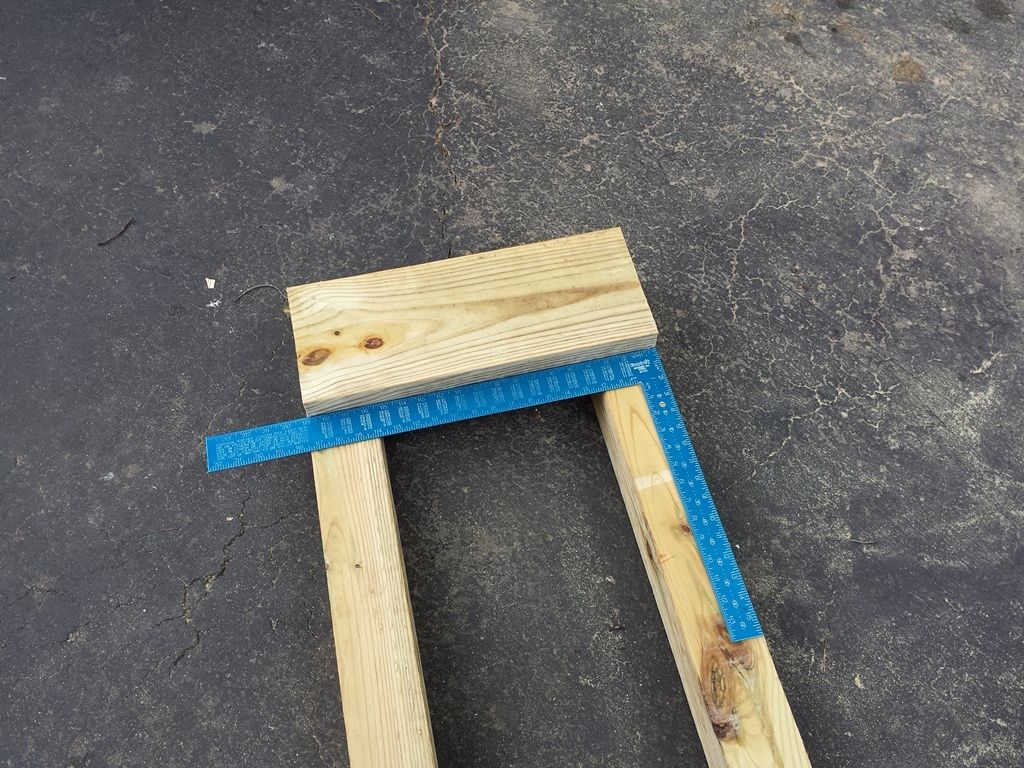 Nailing: 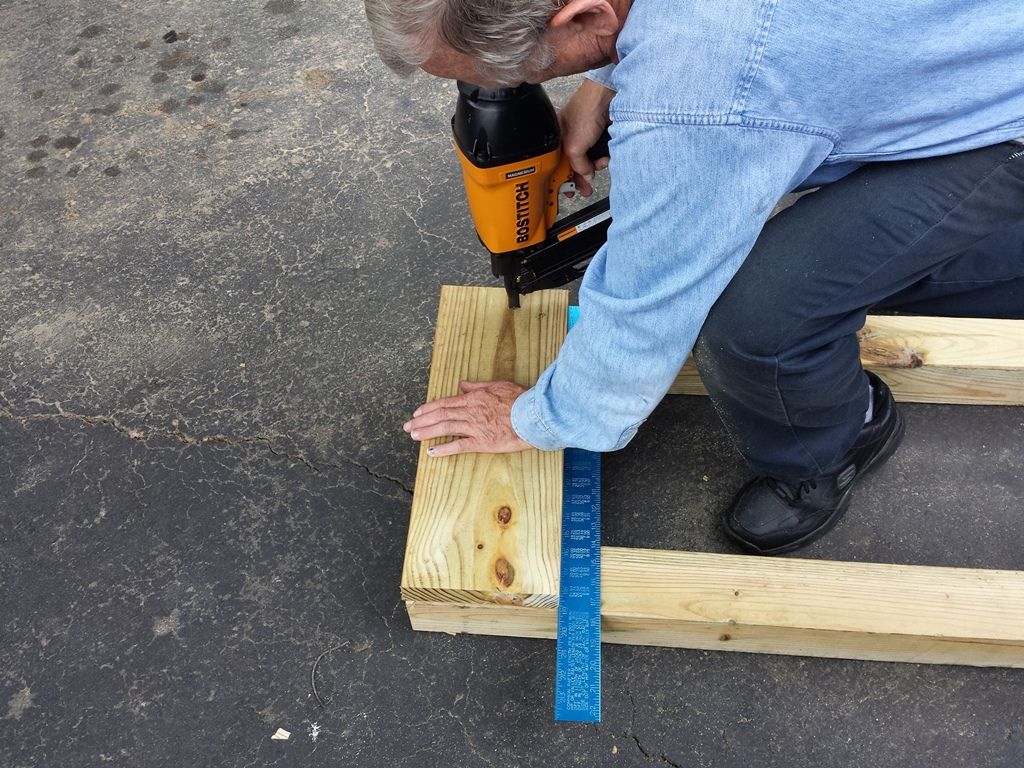 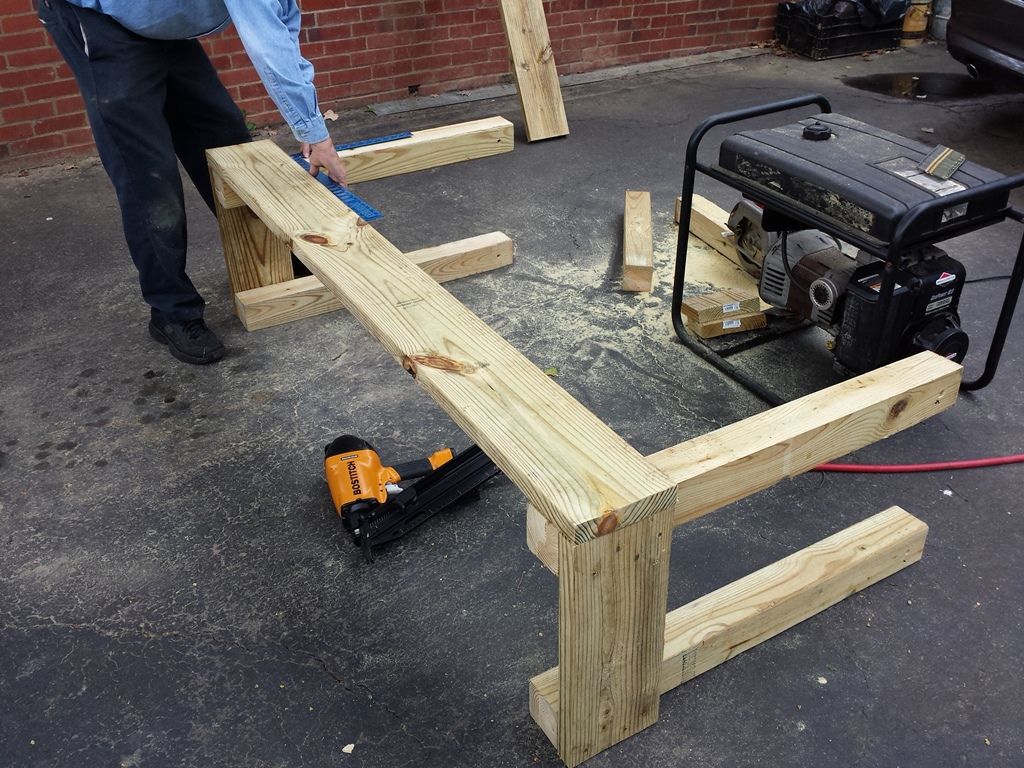 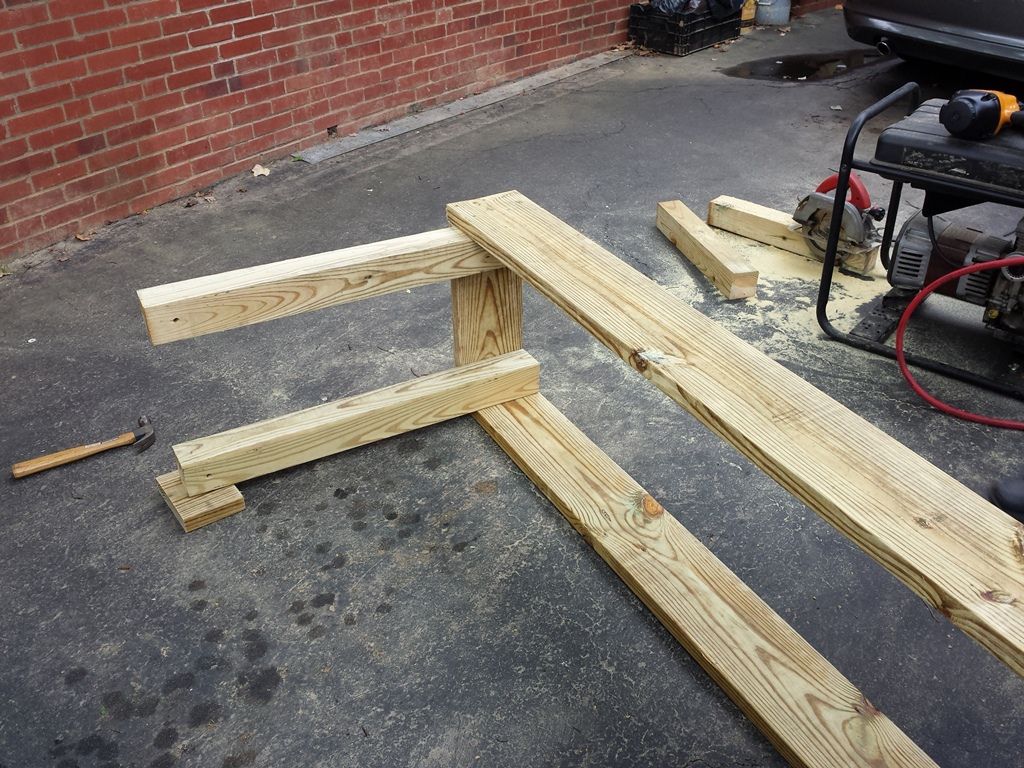 The top is also out of 2 x 8”: 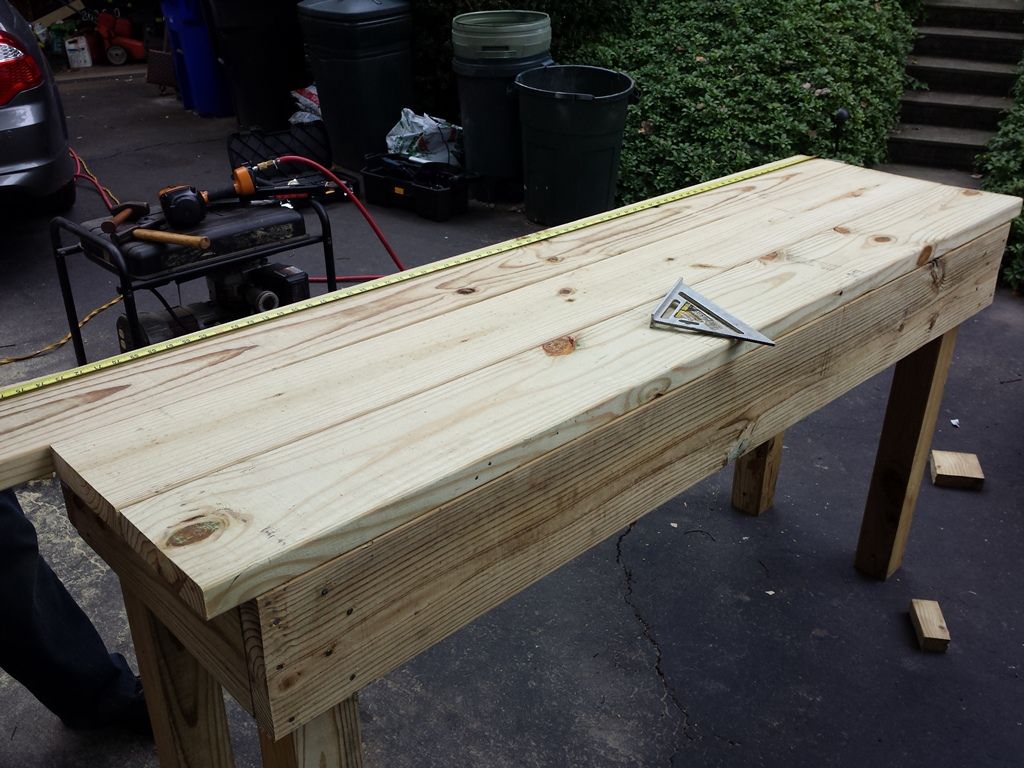 Bottom-side bracing: 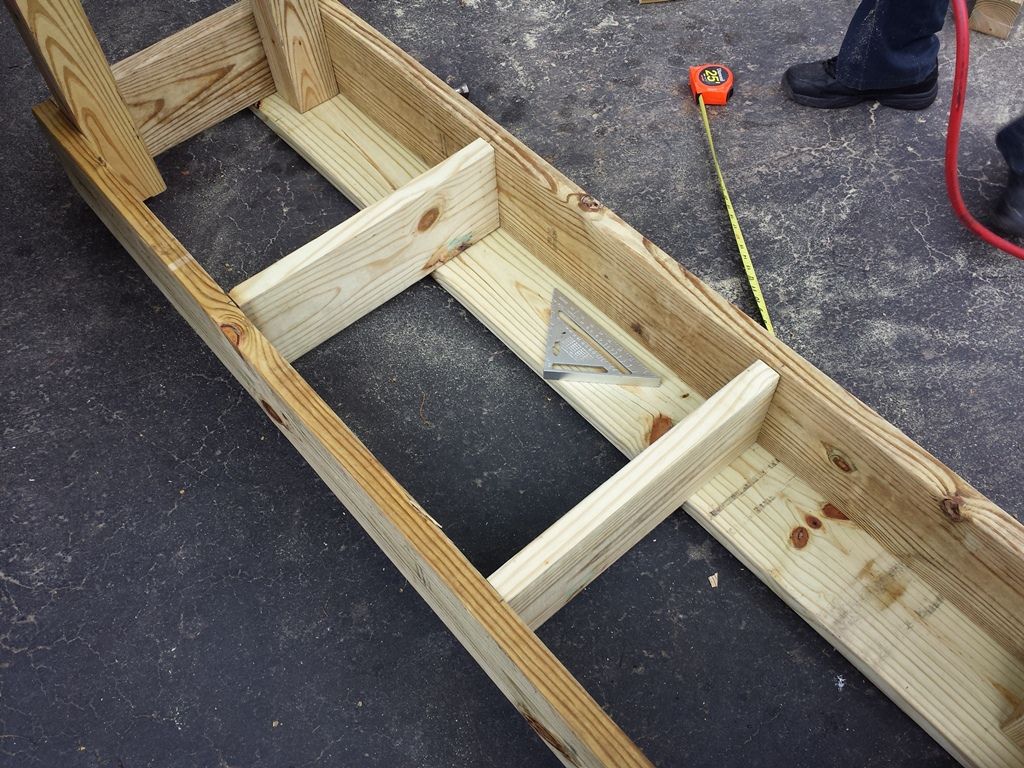 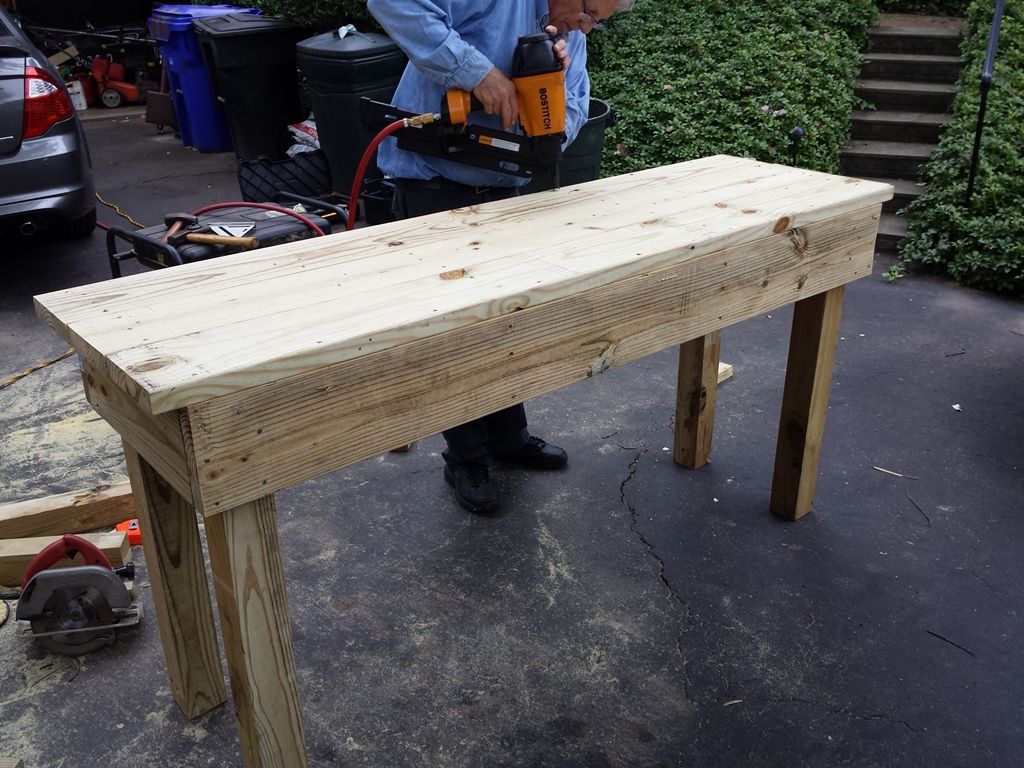 Finished. We purposely left 2” of overhang per end:  Leg tabs installed: 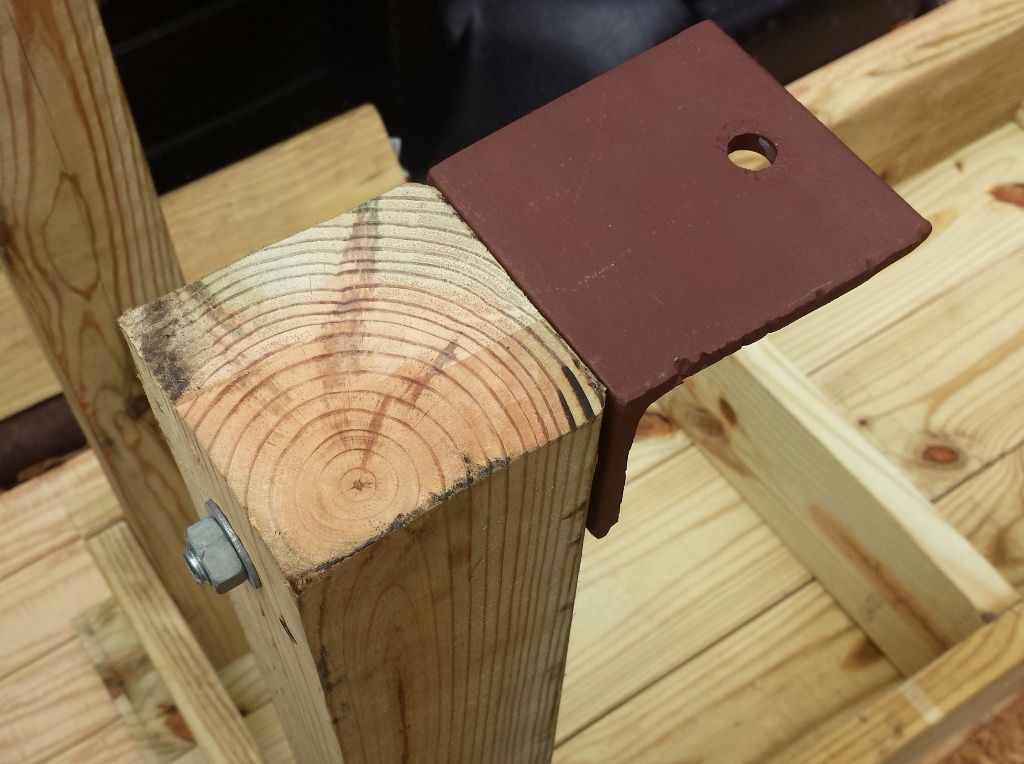 What we haven’t attached yet is a 14” piece of angle-iron. That’ll bolt to the front and serve as a mounting point for my press and powder measure. -Lee www.singleactions.com"Chasing perfection fives shots at a time" |
|
|
|
Post by cherokeetracker on Sept 30, 2015 19:42:44 GMT -5
First Off, I want to thank you Lee for that valuable information, concerning long seating. I really did misunderstand about this thread. But, I am happy about it. I do hope that you know, I am ready for this to continue for a long time. There is just too much information here to pass up.
Charles
|
|
|
|
Post by Lee Martin on Oct 12, 2015 19:11:47 GMT -5
New Range, New Bench – Step 19 ________________________________________ Yesterday we covered the gables and installed the reloading bench. The range is now complete. Below you’ll also see the angle-iron I referenced above. That’s where I’ll clamp my Harrell press and powder measure: 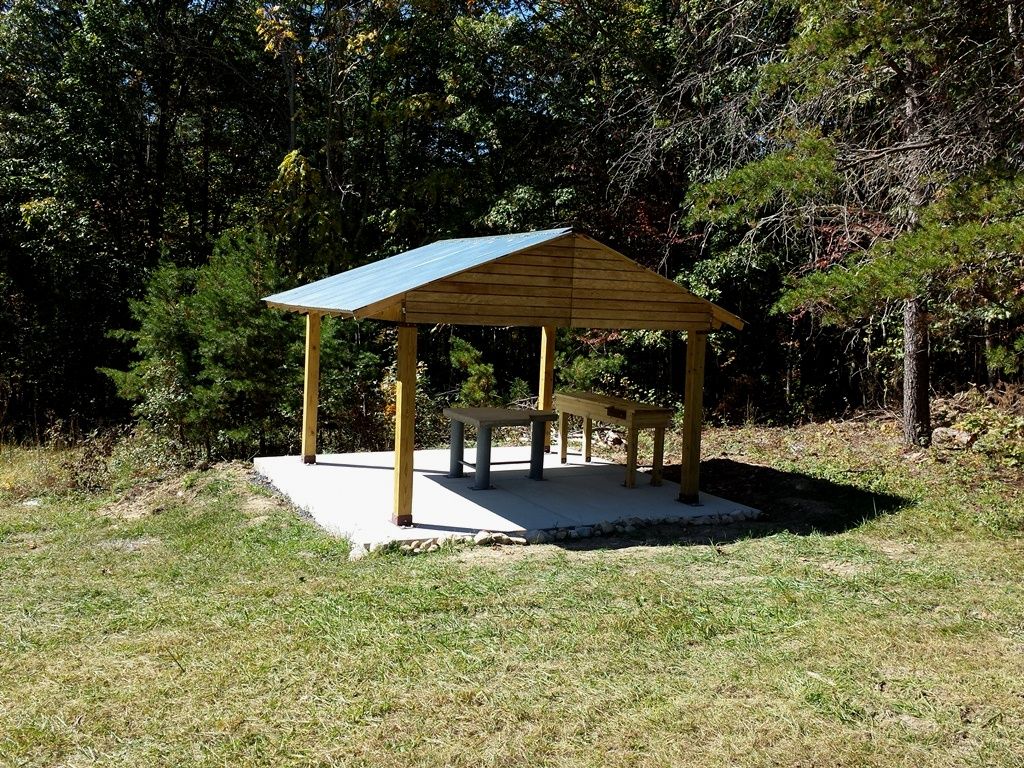 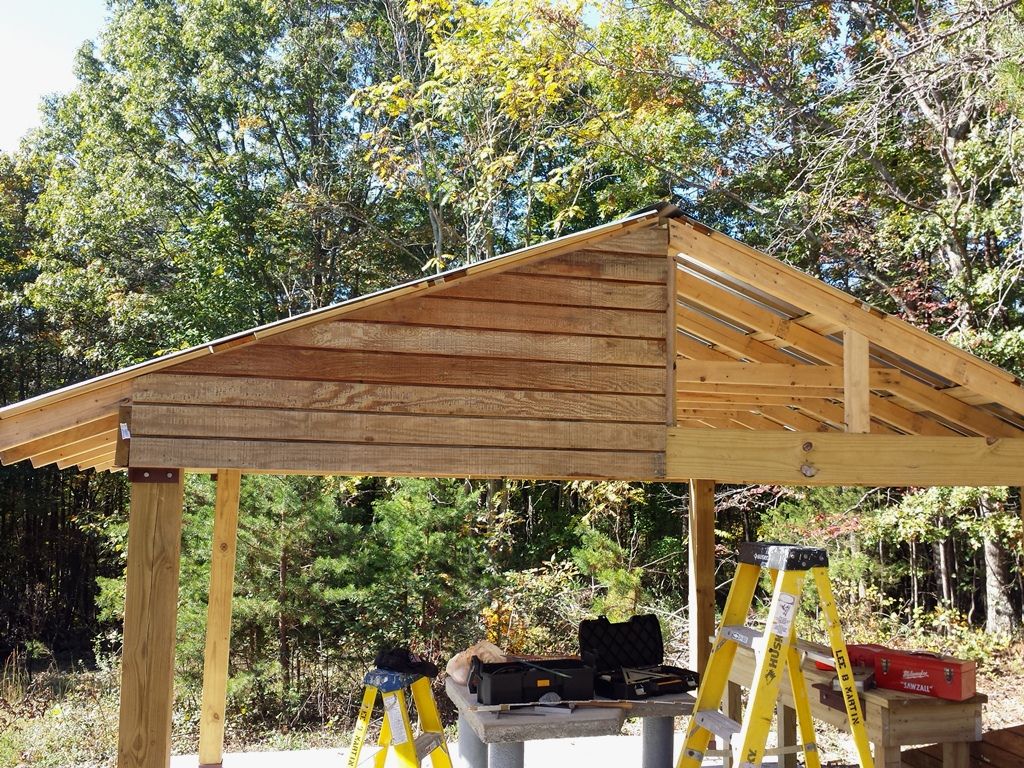 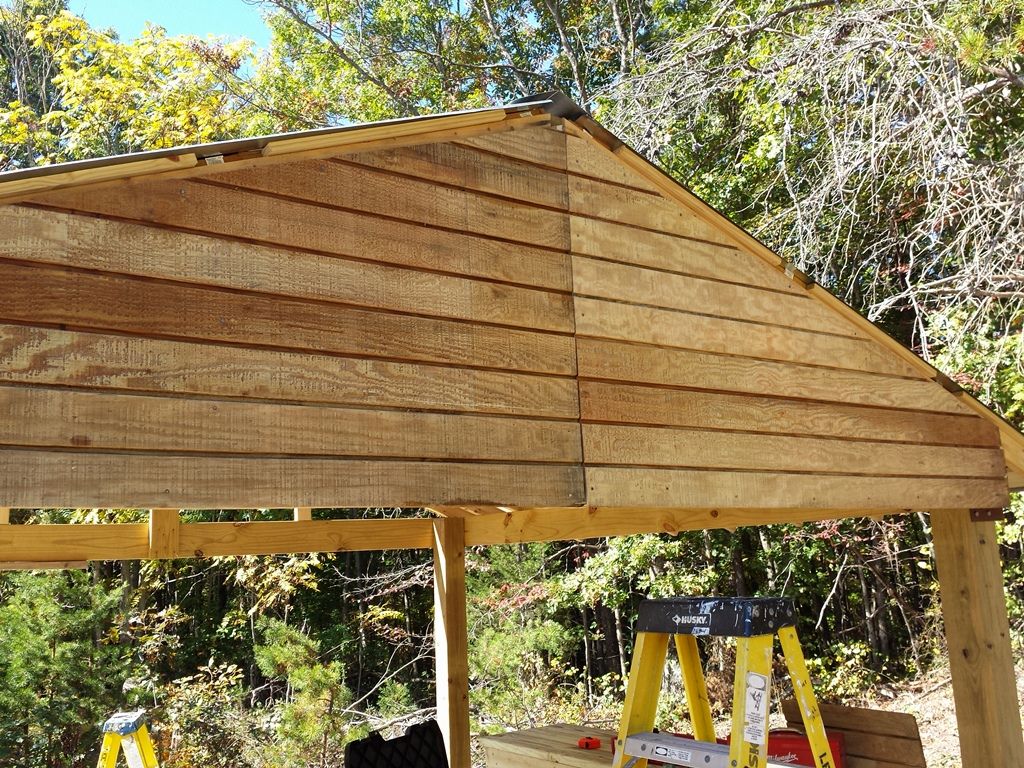 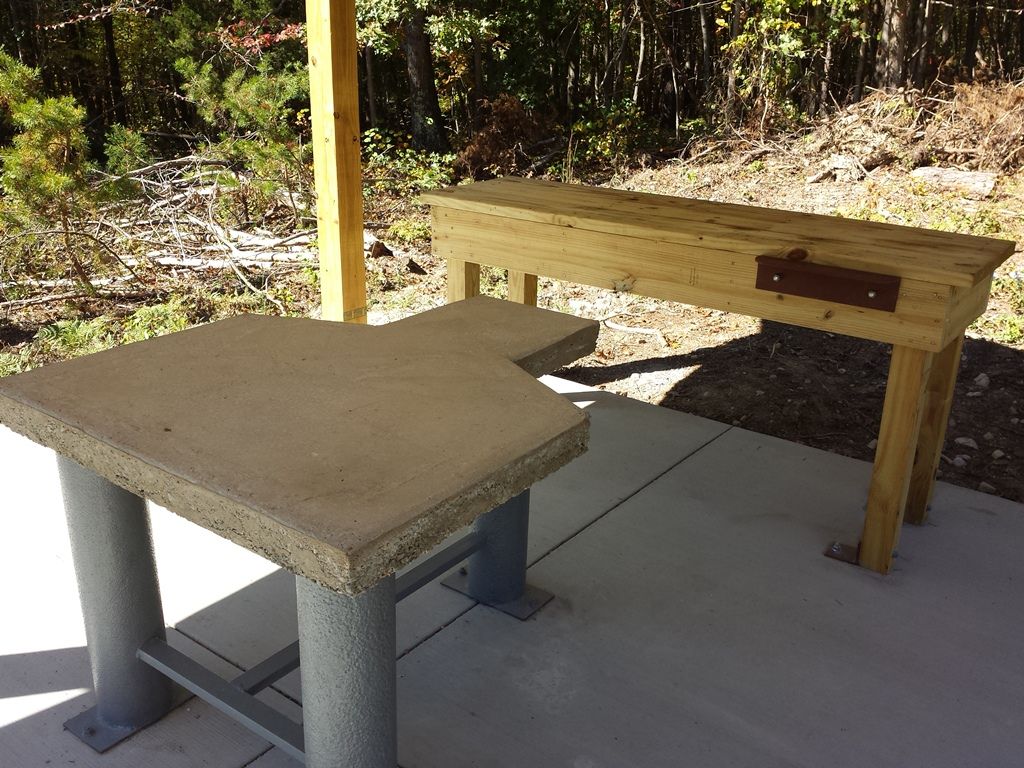  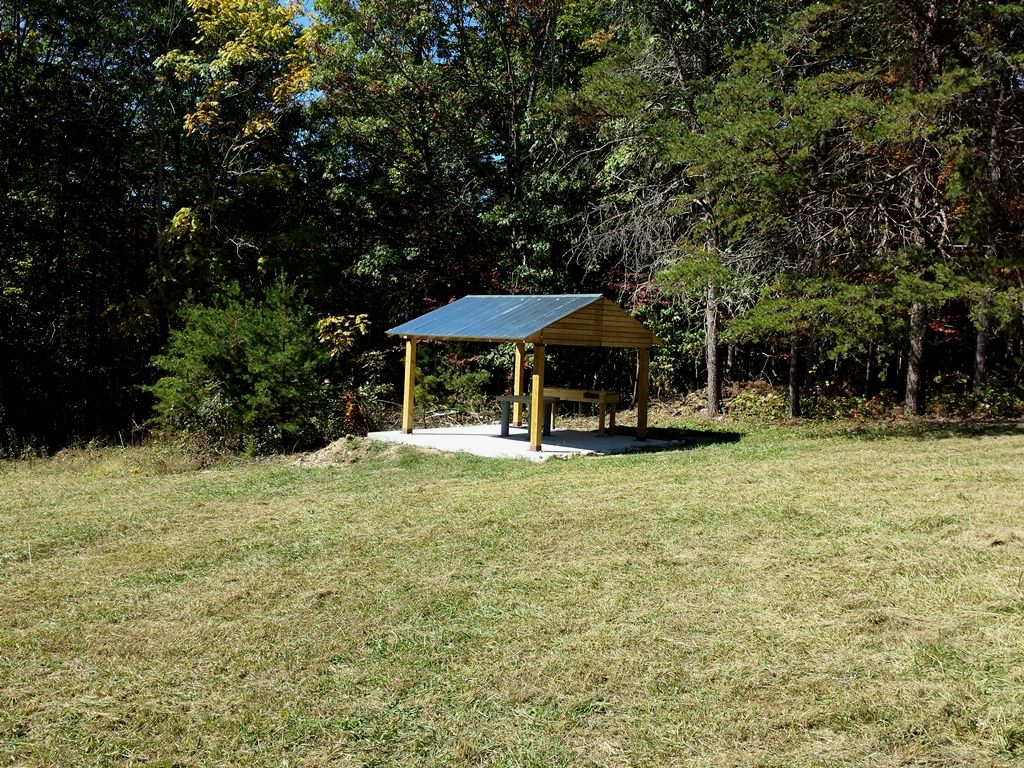 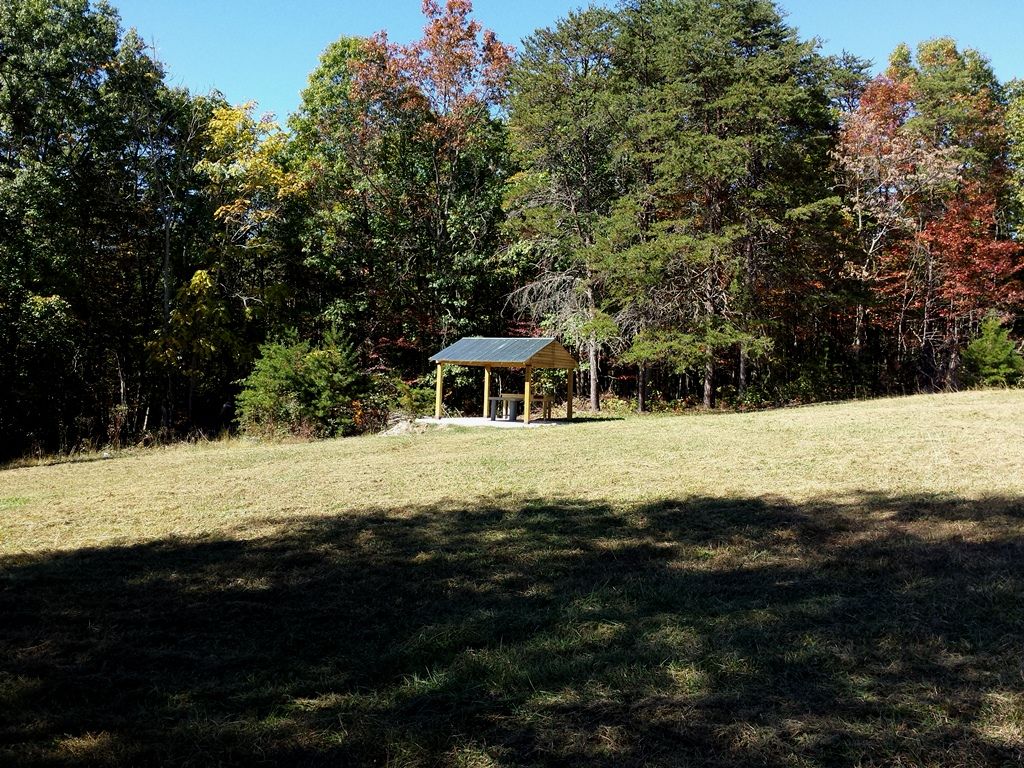 Naturally a new range wasn’t planned when this started in 2013. But I can honestly say it was time well spent. It’ll promote better shooting and I learned construction along the way. And what dad taught me about machining a precision action is priceless. So this brings the build portion of the thread to a close. Now all that’s left is to burn up barrels. But stick around for shooting, more technical posts, and registered matches (I’ll enter both group and score as a member of the IBS and NBRSA). Special thanks to my dad. Words can’t express how much fun I’ve had with this. No other gun project we’ve done even comes close. -Lee www.singleactions.com"Chasing perfection five shots at a time" |
|
|
|
Post by kings6 on Oct 12, 2015 19:16:09 GMT -5
Lee you are truly a blessed man to be able to undertake projects like this with your dad. So many of us are of an age that WE are the dads and projects like this with our fathers are just memories. Thank you for letting join your family journey on this project and for your dad's willingness to take tasks like this on.
Robb
|
|
ericp
.327 Meteor
 
Posts: 522
|
Post by ericp on Oct 12, 2015 19:42:15 GMT -5
This has been absolutely wonderful to follow. There is nothing better than getting to work on projects with your dad. Growing up my dad and I built all sorts of wood boats from traditional cruisers to inboard hydroplanes (and race motors), it is beyond priceless.
I look forward to reading the updates!
Eric
|
|
|
|
Post by squawberryman on Oct 15, 2015 5:25:02 GMT -5
Lee when all the colors come out can you post that last pic again? You had stated you'd address barrel break in sir. Thank you for carrying us along.
|
|
|
|
Post by Lee Martin on Oct 15, 2015 18:30:09 GMT -5
Lee when all the colors come out can you post that last pic again? You had stated you'd address barrel break in sir. Thank you for carrying us along. Sure thing. The leaves will change fast in the coming weeks. Barrel break in – there’s no consensus here except to consider the starting point. Factory bores aren’t meticulously polished and may, underscore ‘may’, benefit from the process. To the contrary, benchrest blanks are hand lapped and air gauged to a few ten-thousandths on concentricity. When held to these standards only the freshly cut throat breaks-in (and that happens within a few rounds). The lands and grooves are already void of burrs and machine marks. Poor barrels are just that throughout. You can’t shoot a bad blank into a good one. The fire a shot, clean, first two shots, clean, and so forth was popular in the 70’s in 80’s. Then bore scopes came on the scene and guys quickly found this didn’t help the barrel. If anything it just wore them out faster. The surface quality from makers like Shilen, Hart, Bartlein, Brux, and Krieger are dimensionally correct and smooth. This is the result of thorough lapping. Every bullet fired down their virgin bores is one less off their competitive life. Several leading manufacturers reiterate this point. Hart, Shilen, and the late Gale McMillan all recommend shooting them straight-up followed by regular and rigid cleaning. Squeezing the trigger for less than sighting the scope or accuracy is a waste of money. -Lee www.singleactions.com"Chasing perfection five shots at a time" |
|
|
|
Post by Lee Martin on Oct 15, 2015 18:34:15 GMT -5
40 Years with the 6 PPC ______________________________________ 40 years ago this past summer Ferris Pindell and Lou Palmisano gave us the 6 PPC. Short-range benchrest would be forever changed. I thought some of you may enjoy seeing the original July 1975 Precision Shooting article: 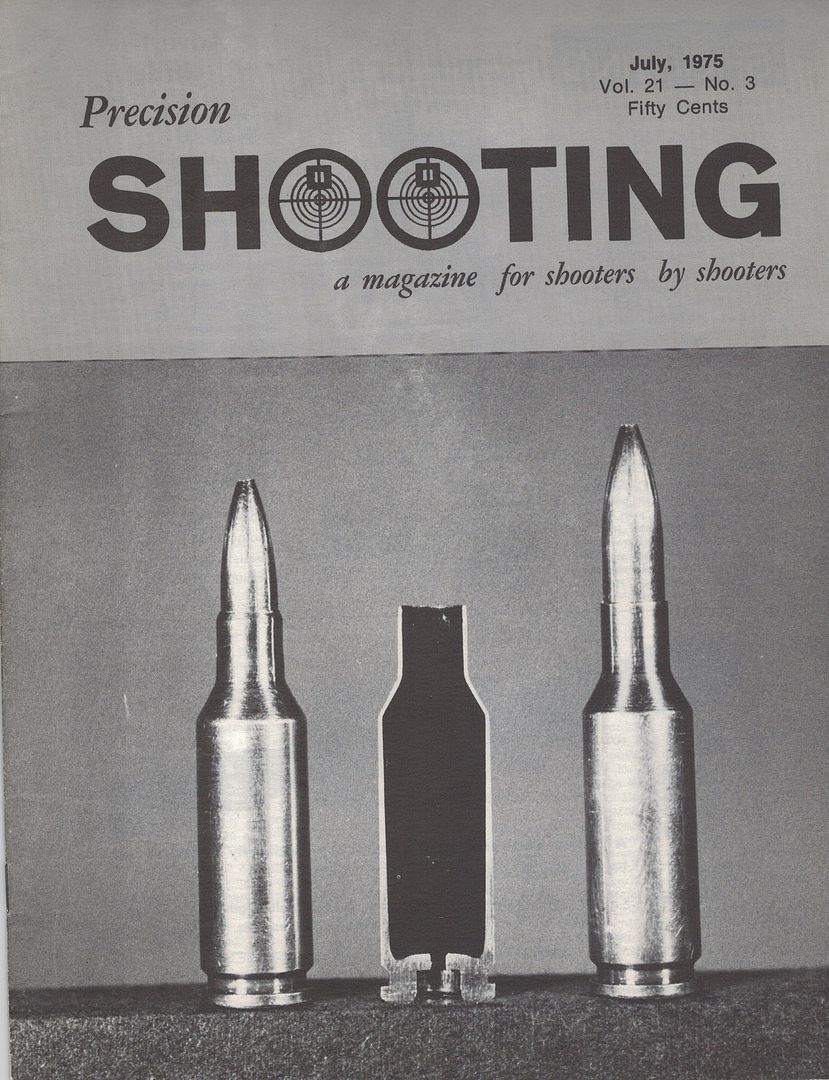 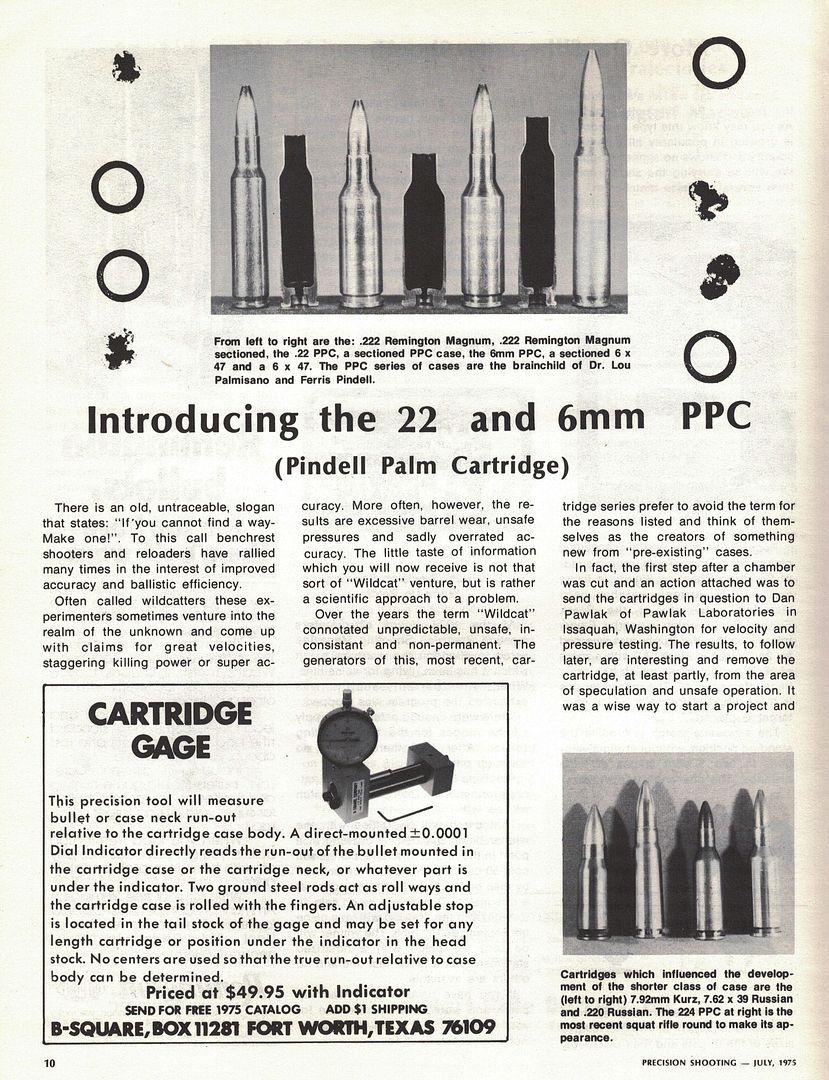 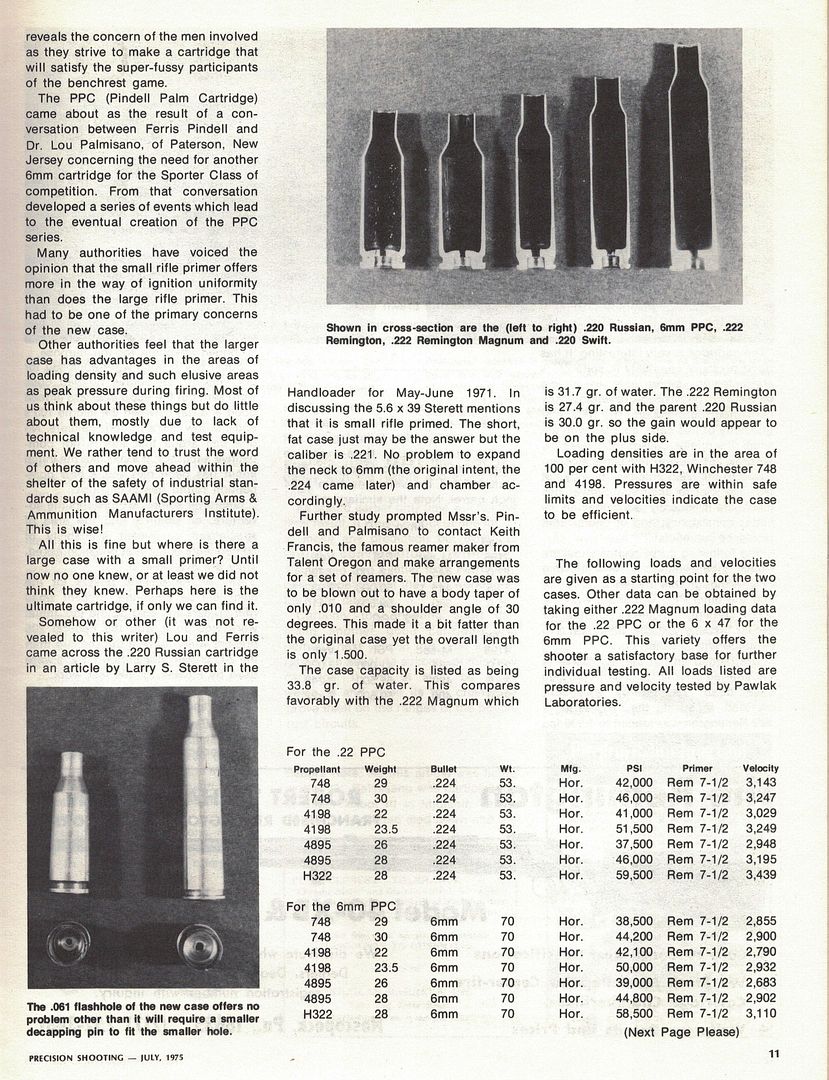 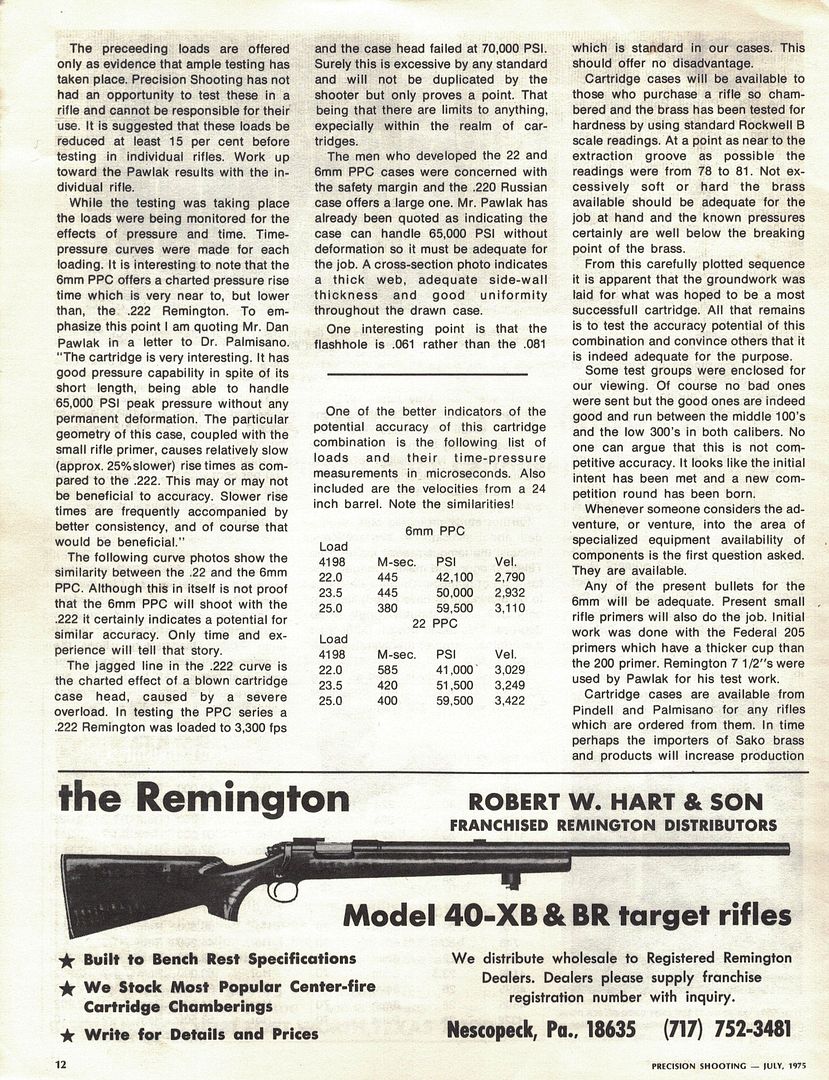  -Lee www.singleactions.com"Chasing perfection five shots at a time" |
|
|
|
Post by Lee Martin on Oct 15, 2015 18:35:55 GMT -5
Ferris' ad in the August 1975 edition of PS:  The first promo they ran for Sako’s PPC cases in late 1976. The interval from release to this ad illustrates how brass was the long pole in the tent. 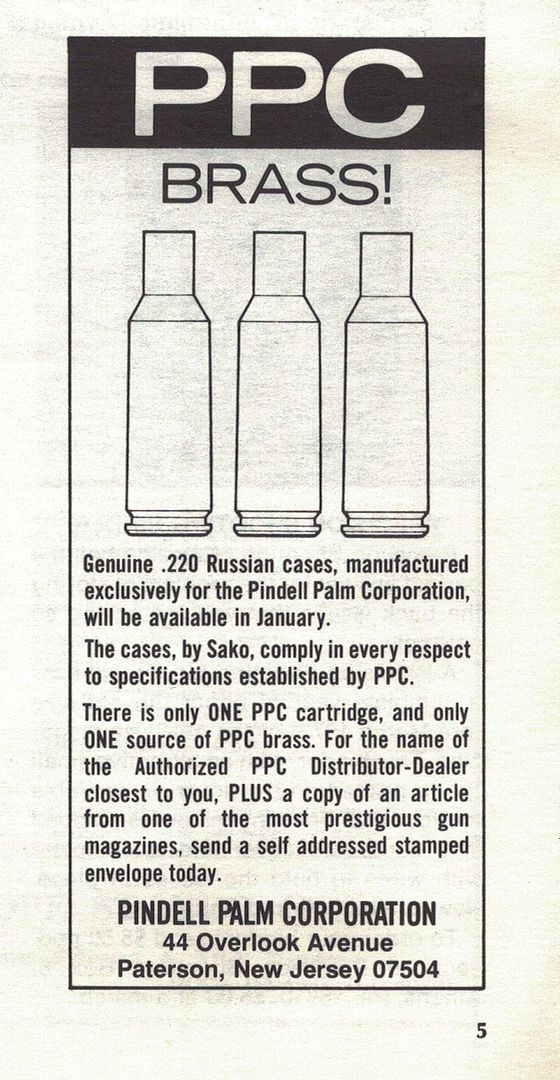 -Lee www.singleactions.com"Chasing perfection five shots at a time" |
|
|
|
Post by bradshaw on Oct 17, 2015 7:52:54 GMT -5
Too many old masters have joined the Feathered Choir without imparting us a record of shooting developments reflecting advances in shooting. By definition the avant garde"----the artisans of guns and the artists of technique----continues as a small percentage of those who shoot. We must now count Lee Martin a member of this clan, for his articles provide a vital link in the chain of information, so honestly presented, upon which history relies.
David Bradshaw
|
|
|
|
Post by Lee Martin on Oct 19, 2015 21:52:51 GMT -5
Cutting Groups - Part II (my first screamer) ___________________________________________________ In precision shooting a screamer group is five shots under 1/10 MOA. That’s 0.10” at 100 yards, 0.20” at 200 yards, and so forth. After 28 years of dabbling in BR I finally dipped into the zeros. My dad first accomplished this with one of his actions in the early 90’s. That group was a 0.091” using a heavy varmint 6 BR. We’ve come close on other occasions, laying down a lot of low 1’s. But screamers are pretty elusive. In registered competition you used to get a patch for the feat. Nowadays they reward you with a decal. At any rate, they’re celebrated. Saturday was cool and very windy. The flags wouldn’t stay on a condition long as our range ‘vortexed’. Being at the base of a mountain and surrounded by trees, the wind comes into the 8 acre field and swirls. The shifts are bi-directional and quick so it’s tricky. Most of the day I was off the gun focused completely on the flags. Timing trigger touch and the desired vane position, I averaged 0.250” with occasional high 1’s. Then came my last 13 rounds which were a heavier charge of LT-32. After cleaning the barrel I did two foulers and shot a 0.231”. Not bad. I set another target, fired one sighter to reheat the bore, and moved to the record bull. Then the wind gave me a pass. All the sudden it calmed and remained so long enough for a group. Minutes later I saw a small hole through the 40X March. Pulling the paper from the backer I guessed low to mid 1’s. It was tight but I wasn’t thinking 0’s. Measuring the target with a caliper said otherwise. The dial read 0.328” across the widest point or 0.085” after subtracting 0.243”. • 28.1 grs of LT-32 (150.5 Culver measure) • Velocity – haven’t chronographed it yet but I’d guess 3,300 fps • 68 grain FB Bart’s Ultra just touching the lands. • Brass – Lapua, 3rd firing • 0.0015” neck tension – 0.261” bushing • CCI BR-4 primer • Shoulder bump = 0.001” • Loaded neck = 0.2625” on a 0.264” chamber. 0.0015” clearance • Average wind = 0.8 mph during the five minutes it took to complete • Temp = 50.3, Humidity – 48.4 • Free recoil throughout Back home we checked it under a microscope. Dad put the widest span at 0.320”, meaning the group scored 0.077” (0.320” minus the bullet diameter). 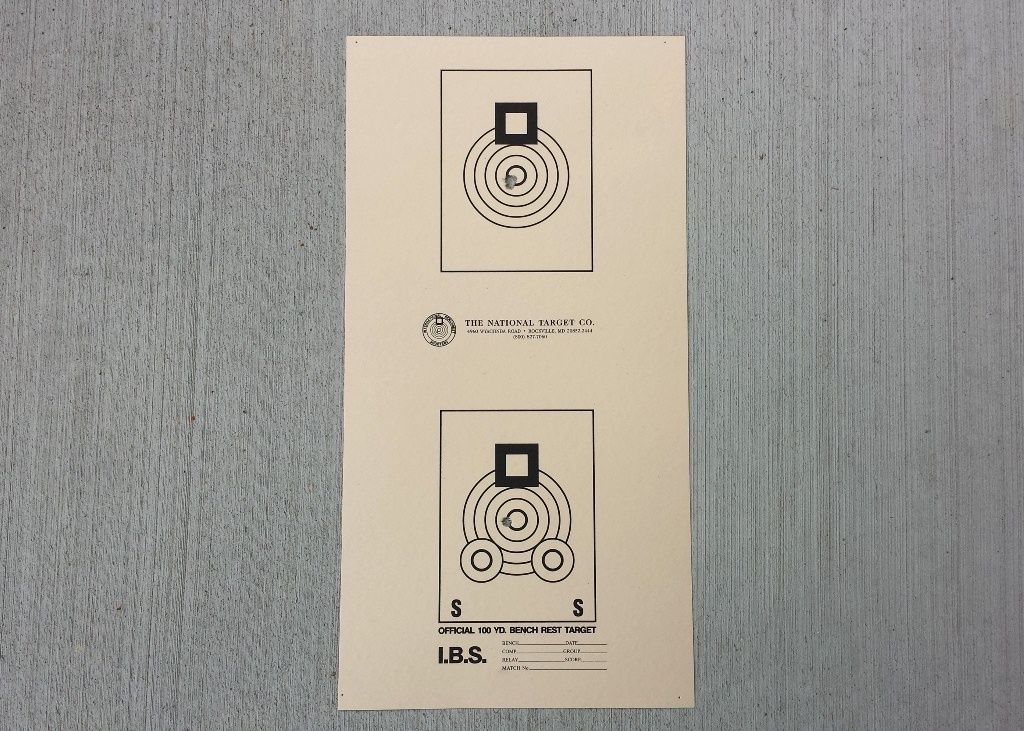 Measuring at the range:  Measuring under magnification: 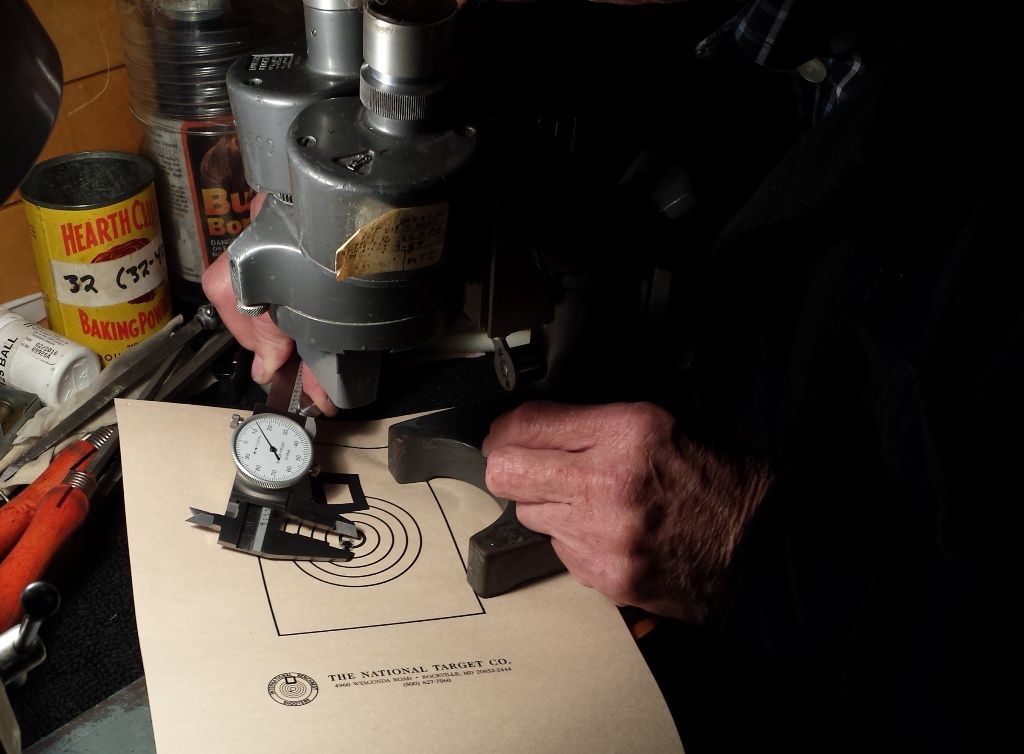 The loading bench: 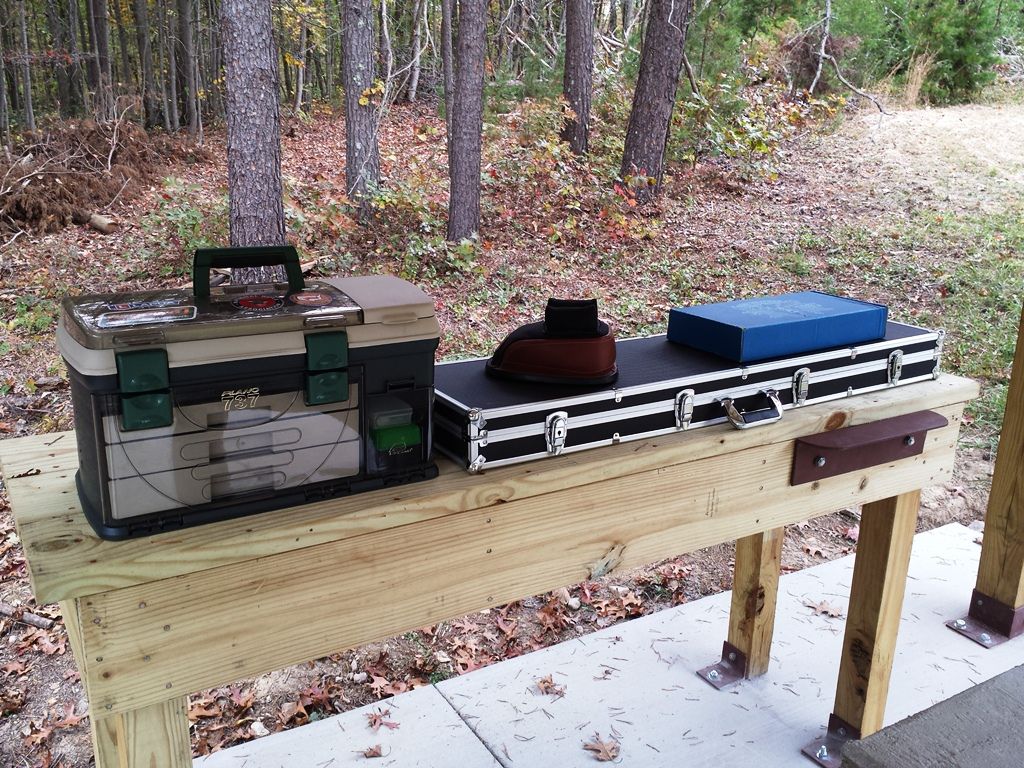 And if you’re wondering about the blue Freedom Arms box, BR targets fit them perfectly. -Lee www.singleactions.com"Chasing perfection five shots at a time" |
|
|
|
Post by Lee Martin on Oct 22, 2015 19:14:59 GMT -5
Load Tuning ___________________________________ You’ve heard me refer to load tuning throughout this thread. Sounds abstract, doesn’t it? I’ll attempt to tune my PPC this Saturday and wanted to revisit the subject. If you recall from page 9, upon firing the barrel vibrates like a cantilevered rod: 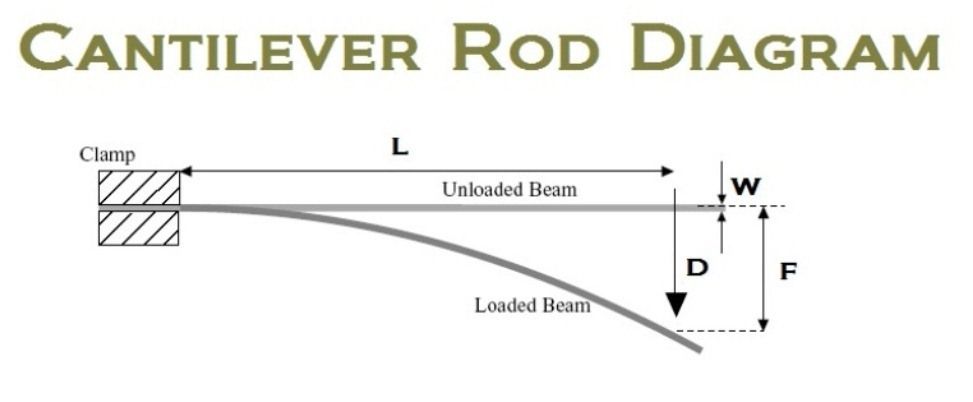 These vibrations transverse the entire barrel and mimic a sine wave. 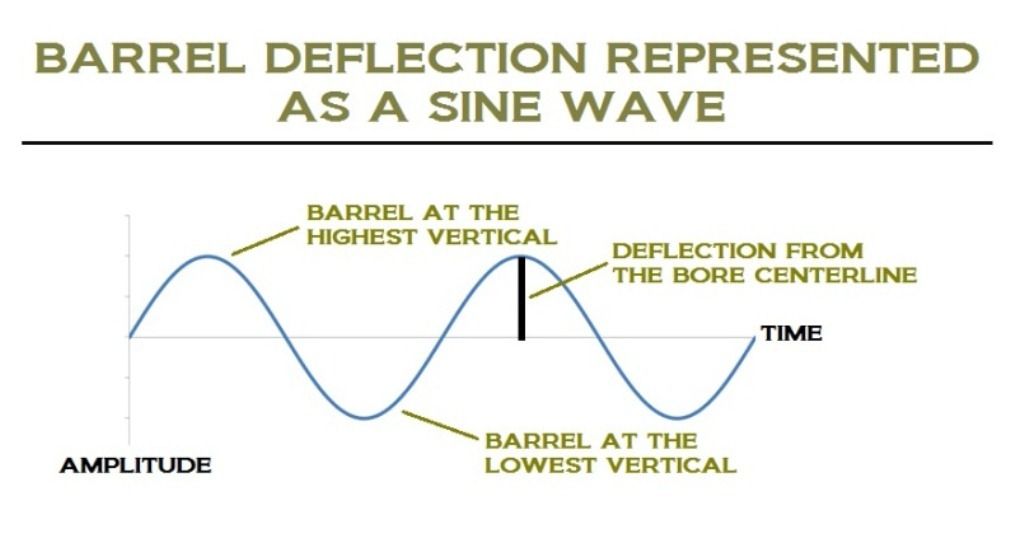 The shorter and thicker the barrel, the lower amount of total deflection top to bottom. Just as important are the peaks and valleys of each node. At those points barrel movement is the least as the wave pauses to change direction. Movement at the bore centerline is the greatest. For that reason we want to tune loads so the bullet exits at or around the node tips. Again, it doesn’t matter if it’s the upper or lower so long as barrel whip is slowed. The inputs we tune by for a given powder & bullet combination are: • Powder charge • Bullet seating depth • Neck tension I’ve settled on LT-32 powder and Bart Sauter’s 68 gr Ultra FB for this barrel. Two tensions have been tried, 0.0015” and 0.0025”. LT-32 hasn’t shown a preference between the two and anything over 0.0025” is excessive. Unlike N133, guys tell me LT-32 doesn’t want much pull. So for this exercise I’ll size with a 0.261” bushing or 0.0015” tension. The tune trial – my initial shooting puts LT’s charge window between 26.9 and 28.4 grs. You can push it to 29.0 but let’s start conservative. Saturday I’ll load onsite with four weights – 27.1, 27.7, 28.1, and 28.4 grains. Each will then see four seating depths – 0.005” in or ‘jam’, just touching the lands, 0.005” off (jump), and 0.010” off. Using a Sinclair practice target, every combination is fired as a three shot group and assessed. A visual of the load array and layout: 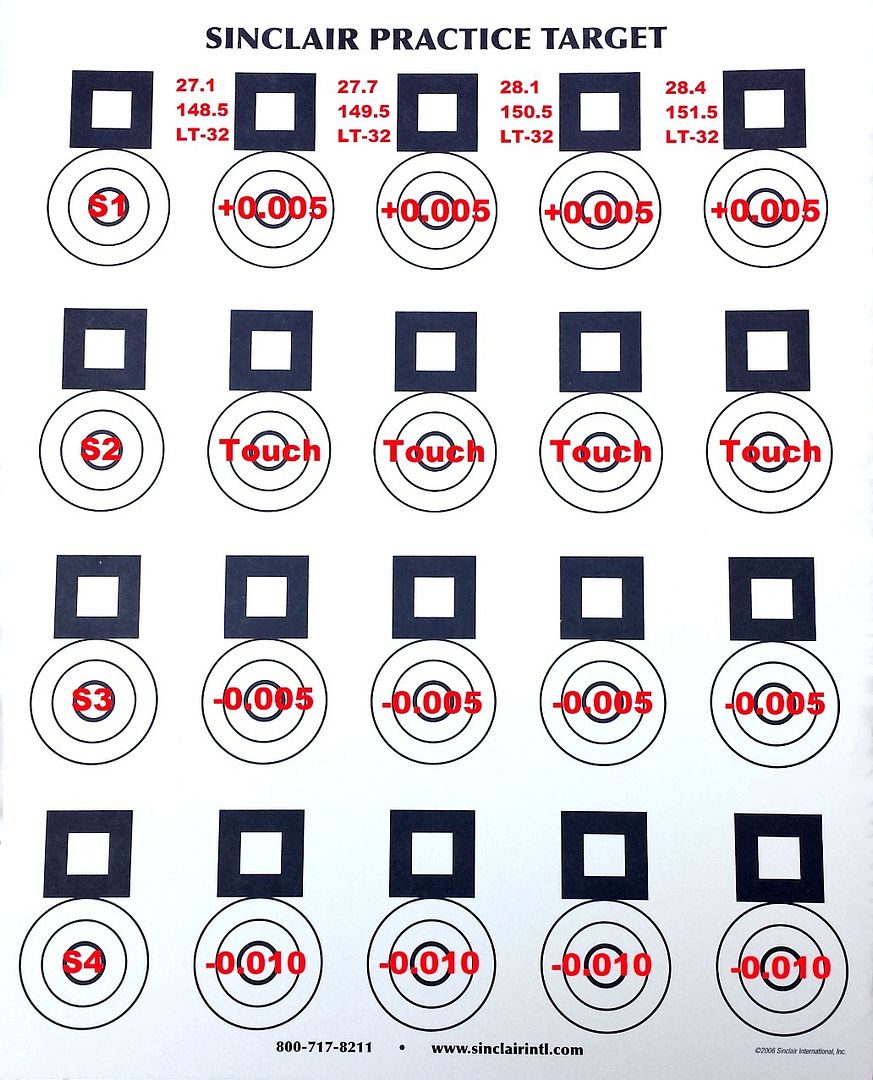 The “S” bulls on the left are reserved for foulers. What I’m looking for across the groups isn’t just their size. Their pattern matters too. A lot of vertical suggests we’re in between nodes. Also where do the point-of-impacts fall? Believe it or not, you can surmise up or down deflection by this. For a set charge, does the cluster print high or low? Often times the three shots will hit higher on the mothball but tight. The next depth may print in the middle but open a bit. The last depth tried may drop down from that position and retighten. While it’s hard to prove, the first group is probably on the up node, the second is mid-sine wave, and the third is the lowest point of deflection (ie, the down node). Powders ideal for benchrest have wide nodes. That’s to say you can stay on a tip over 0.3 – 0.5 grain spans. Illustrated: 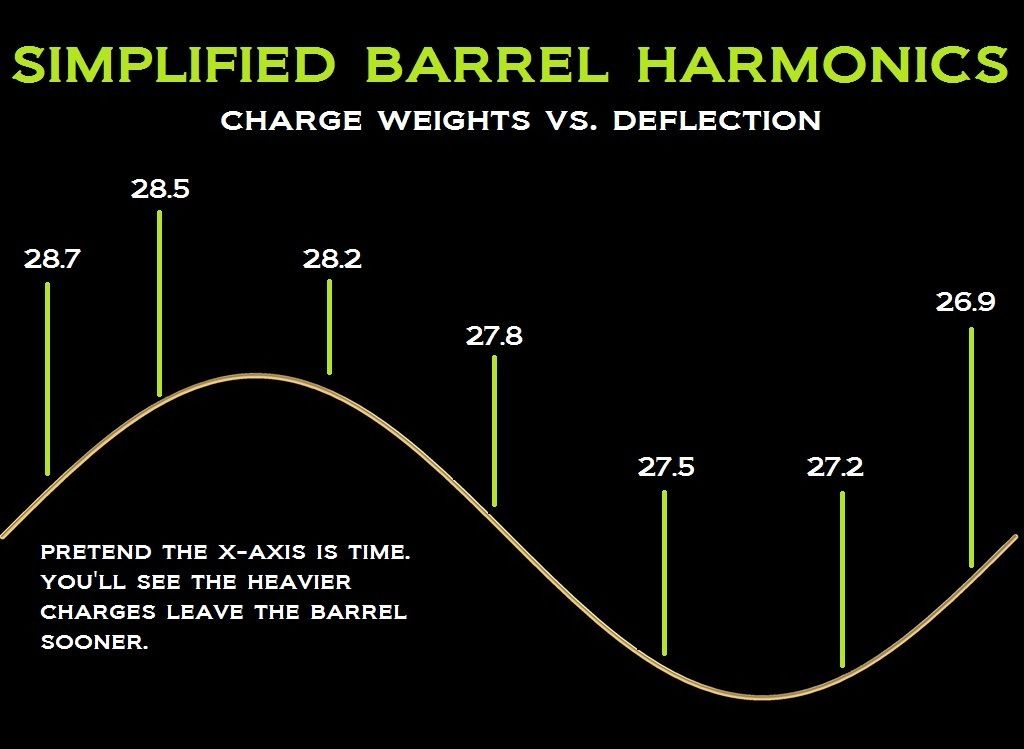 In this example say the barrel prints the best at touch. Altering the powder charges for that depth yields two nodes: 1) The upper is between 28.2 and 28.5 2) The lower goes in 27.2 to 27.5 We’d want to avoid 27.4 – 28.1 grains. At least we would until the conditions change. But I’ll save tuning to temperature, humidity, and density altitude for later. Key takeaway - underpinning any tune trial is a simple rule. Lowering deflection makes it easier to tune to node peaks and valleys. The more the barrel whips, the harder it is to time bullet exit with sine wave transition. Next week I’ll let you know how the gun fares. -Lee www.singleactions.com"Chasing perfection five shots at a time" |
|
cmillard
.375 Atomic
   MOLON LABE
MOLON LABE
Posts: 1,997
|
Post by cmillard on Oct 25, 2015 9:11:51 GMT -5
nice shooting!!
|
|
|
|
Post by Lee Martin on Oct 27, 2015 20:12:53 GMT -5
Load Tuning Results ____________________________ Last Saturday the rifle revealed a node over one grain of LT-32. I was short on time however and only tried three charges – 27.1, 27.7, and 28.1. Eventually I’ll pour 28.4 grs to see about a higher position. But for now I’m content with what I saw in these three. My practice target - to recap, the bulls on the far left are fouling shots. Moving to the right, we have 27.1, 27.7, and 28.1 grains and four depths. The top circle is +0.005” into the lands followed by touch, -0.005” off, and -0.010” off. 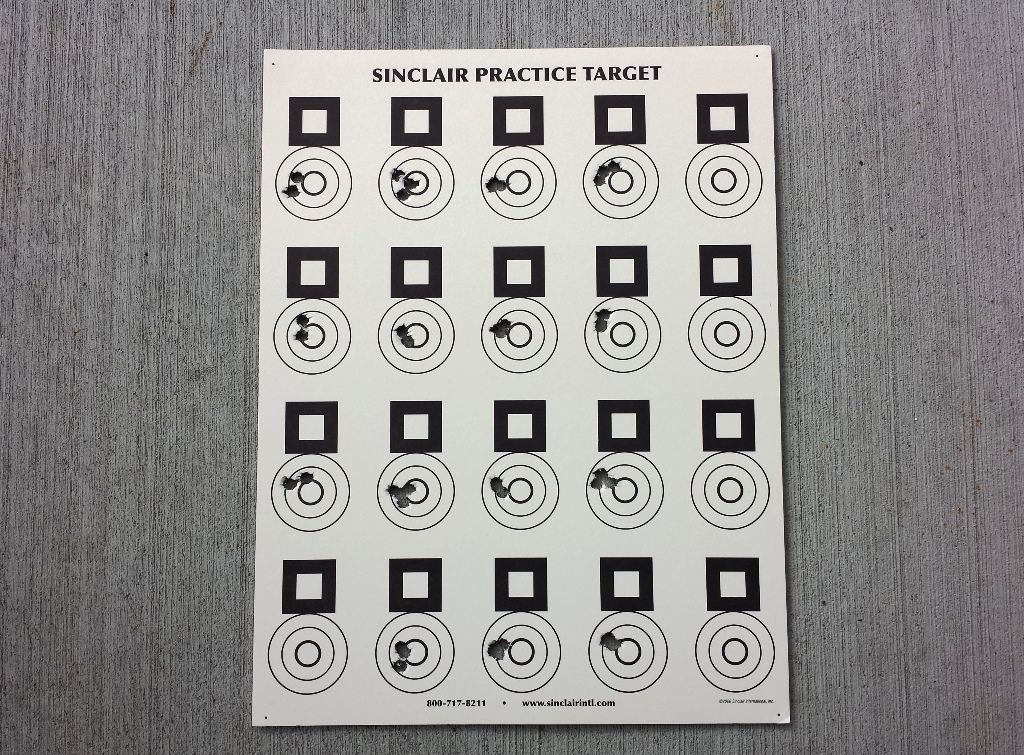 Clearly the barrel doesn’t like 27.1 grs at any OAL. There’s big vertical and only when kissing the lands do the three converge. Conditions were mild so I believe 27.1 is a node transition. With H322 and the T-32/8208 surplus powders, 27.7 grs was popular for 66 – 68 gr bullets. Just check old matches and you’ll find a lot of success with that combination. My PPC liked this weight too. At every depth the groups were tight and the rifle tracked*. Equally impressive, this string was shot during the day’s stiffest conditions (* in tune rifles recoil more fluidly than ones that are out of tune. The latter tend to jerk on the bags. 27.7 was real smooth). Vertical returned at 28.1 though it wasn’t as tall as 27.1. Two things to ponder: 1) Adding velocity wrings out some vertical dispersion. Yet no increase will completely eliminate it in node transition, and 2) The POI is a hair higher than 27.7. This could be from the extra fps and/or landing on the front edge of the next node (which would be an upper). You’ll recall this PPC did 2’s with 26.9 grains in spite of 0.040” jump. I suspect 26.9 and 27.7 are nodes with the ensuing tip around 28.2 – 28.4. Of course these may not hold for a wide range of temperatures and humidities. Next steps - this Saturday I’ll shoot 27.7 grains exclusively at touch and -0.010”. Consistency over many 5-shot groups and tougher conditions is TBD. -Lee www.singleactions.com"Chasing perfection five shots at a time" |
|